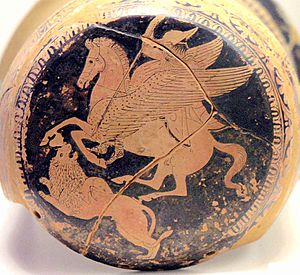Epinetron facts for kids
The epinetron (pronounced eh-pee-NET-ron) was a special piece of ancient Greek pottery. It was shaped to fit over a woman's thigh. Women wore it while preparing wool, almost like a thimble for the leg! Another name for it was onos (pronounced OH-nos).
Contents
What Was an Epinetron?
An epinetron was a unique pottery item used in ancient Greece. It was designed to be worn on a woman's thigh. This helped protect her leg while she worked with wool. Think of it as a protective cover for the upper leg.
How Epinetra Were Used
Women in ancient Greece spent a lot of time preparing wool. They would clean and spin it into thread. The epinetron made this work easier and safer. It kept the rough wool fibers from irritating their skin. The top surface of the epinetron was often made rough. This helped to rub and prepare the wool fibers.
Special Meanings and Decorations
Epinetra were more than just tools. They were also important symbols. Working with wool was seen as a key skill for an ideal wife and woman. Famous stories, like Penelope weaving in the Odyssey, show this connection. Because of this, epinetra were often linked to weddings.
Many epinetra were beautifully decorated. Sometimes, they showed scenes from myths or daily life. A common decoration was a female head placed at the closed end. This part covered the knee. Some epinetra even featured images of Amazon women. For example, a famous epinetron painted around 500-490 BCE by an artist called the Sappho Painter showed Amazon warriors.
Epinetra as Gifts and Memorials
Decorated epinetra were sometimes placed in the graves of young, unmarried girls. This honored their memory and their connection to traditional women's work. They were also given as gifts to temples. These gifts were usually offered to goddesses who were important to women.
See also
 In Spanish: Epínetro para niños
In Spanish: Epínetro para niños


